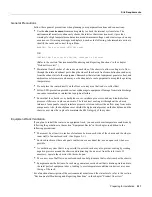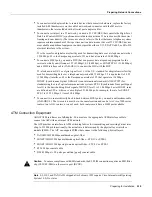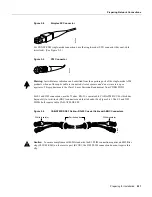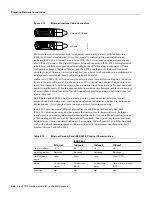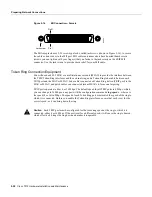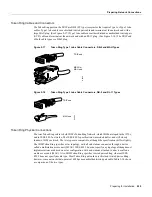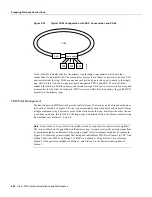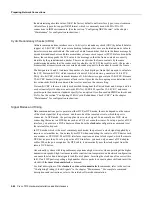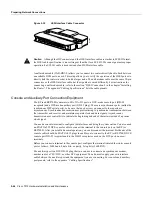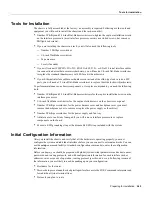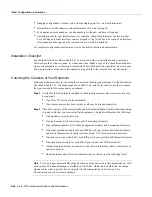
Preparing for Installation 2-31
Preparing Network Connections
The information frame continues to circle the ring until it reaches the original sending station, which
checks the returned frame to ensure that the destination station received the information. When the
original sending station determines that the receiving station accepted the information, it purges the
token and information frame, and transmits a new free token out to the ring.
While the information frame is circling the ring, there is no token on the network (unless early token
release is enabled, which is described later in this section), so other stations wishing to transmit must
wait. Therefore, collisions cannot occur in Token Ring networks.
A priority scheme allows the user to designate any station as high priority, which allows the station
to use the ring more frequently than lower-priority stations. Stations cannot seize or reserve a passing
token with a higher priority than its own designated priority, which allows highest-priority stations
to seize the token as soon as possible. The token frame contains a priority field, which is set by the
station that generates the token, and a reservation field, which can be set by a higher-priority station
as it receives and passes the token.
When a token is circulating, only stations with a priority equal to or higher than the priority value in
the token fields can seize that token or reserve the next token. Once the token is seized and changed
to a busy token with an information frame, a station with a higher priority than the transmitting
station can reserve the next token (for the next pass around the network) by setting the reservation
field. When the original sending station receives a token with the reservation field set for a
higher-priority station, it issues the new free token with the priority field set to that of the reserving
station. Only the reserving station or another station with an equal or higher priority can seize the
token. After the higher priority station seizes the token and completes its transmission, it must first
determine that all other higher-priority stations are finished transmitting then reinstate the previous,
lower priority. When the station detects a free token with the higher priority, it assumes that there is
no more higher-priority traffic waiting and downgrades the priority of the token before passing it
back onto the ring.
Early token release allows a station to release a new token onto the ring immediately after
transmitting, instead of waiting for the first frame to return. This feature can help increase the total
bandwidth on the ring, but decreases ring reliability. The TRIP supports early token release, but by
default it is not enabled on any TRIP ports.
Unlike CSMA/CD networks such as Ethernet, token-passing networks are deterministic. Each
station can hold the token for a maximum period of time, so it is possible to calculate the maximum
time that will pass before any end station will be able to transmit. This and the fault management
mechanisms discussed in the following section make Token Ring networks robust and predictable.
Token Ring Fault Management
Token Ring networks employ several mechanisms for detecting and compensating for network
faults. For example, one station in the Token Ring network is designated as the active monitor. This
station, which potentially can be any station on the network, acts as a centralized source of timing
information for other ring stations and performs a variety of ring maintenance functions. These
functions include detecting and correcting a lost or persistently busy (continuously circulating)
token on the ring.
To detect a lost token, the active monitor uses a timeout greater than the time required for the longest
frame to traverse the ring completely. If the active monitor does not see a token during this time, it
assumes that the token is lost, purges the ring of any residual data, and issues a new token.
When a sending device fails, its frame may continuously circle the ring, preventing other stations
from transmitting their own frames and essentially locking up the network. To detect a circulating
busy token, the active monitor sets a monitor bit to 1 on any passing busy token. If it sees a busy
token with a bit already set, it knows that the transmitting station failed to purge its packet. The
monitor changes the busy token to a free token, and sends it back out to the ring.
Содержание TelePresence Server 7010
Страница 10: ...x Cisco 7010 Hardware Installation and Maintenence ...
Страница 14: ...iv Cisco 7010 Hardware Installation and Maintenance Document Conventions ...
Страница 112: ...2 52 Cisco 7010 Hardware Installation and Maintenance Initial Configuration Information Page ________ ...
Страница 148: ...3 36 Cisco 7010 Hardware Installation and Maintenance Using the Flash Memory Card ...
Страница 158: ...4 10 Cisco 7010 Hardware Installation and Maintenance Troubleshooting the Processor Subsystem ...
Страница 242: ...5 84 Cisco 7010 Hardware Installation and Maintenance Replacing Internal Components ...
Страница 258: ...A 16 Cisco 7010 Hardware Installation and Maintenance MIP Interface Cable Pinouts ...
Страница 270: ...B 12 Cisco 7010 Hardware Installation and Maintenance Interface Processor LEDs ...
Страница 274: ...C 4 Cisco 7000 Hardware Installation and Maintenance ...
Страница 287: ...Index 13 ...

